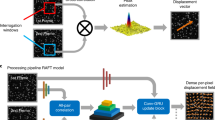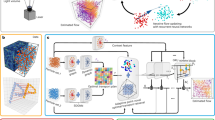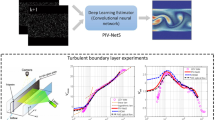Abstract
The velocity resolution for particle tracking velocimetry is limited by the ability to link multiple instances of the same particle captured over time to form trajectories. This becomes increasingly difficult as the particle speed and concentration increase. To address these concerns, we propose a data-driven approach to generate a learned predictive model capable of accurately estimating future particle behavior. The model uses the long short-term memory (LSTM) recurrent neural network architecture to predict a particle’s velocity from its past positions. The model achieves increased linking performance with a negligible increase in the computational cost. Historical trajectories demonstrating the range of expected behaviors for a given application are used to train the model and can be collected using either of two methods. Manual filtering and selection can be used to select exemplary trajectories produced by an incomplete or inadequate method. Supplemental experiments with reduced tracer concentration can also produce training data. Both methods are demonstrated through experimental validation. The ability of the learned predictor to accurately link particles at tracer concentrations and flow speeds where traditional methods fail is demonstrated using two simulated flow cases. Three experimental cases are presented to demonstrate the performance of the proposed method under challenging conditions. Each case tracks the 3D positions of particles captured using microscopic digital inline holography although the approach is generalizable and can be applied to data obtained with other 2D and 3D PTV techniques. The selected cases—turbulent channel flow, flow through a T-junction, and swimming microorganisms—demonstrate the broad applicability of the proposed method to different fields with unique challenges.
Graphic abstract











Similar content being viewed by others
References
Allan D, van der Wel C, Keim N, Caswell TA, Wieker D, Verweij R, Reid C, Thierry, Grueter L, Ramos K, Apiszcz, Zoeith, Perry RW, Boulogne F, Sinha P, Pfigliozzi, Bruot N, Uieda L, Katins J, Mary H, Ahmadia A (2019) Soft-matter/trackpy: Trackpy v0.4.2. https://doi.org/10.5281/ZENODO.3492186
Ault JT, Fani A, Chen KK, Shin S, Gallaire F, Stone HA (2016) Vortex-breakdown-induced particle capture in branching junctions. Phys Rev Lett 117(8):1–5
Baek SJ, Lee SJ (1996) A new two-frame particle tracking algorithm using match probability. Exp Fluids 22(1):23–32
Chollet F et al (2015) Keras. GitHub. https://github.com/fchollet/keras
Cowen EA, Monismith SG (1997) A hybrid digital particle tracking velocimetry technique. Exp Fluids 22(3):199–211
Crocker JC, Grier DG (1996) Methods of digital video microscopy for colloidal studies. J Colloid Interface Sci 179(1):298–310
Dabiri D, Pecora C (2019) Particle tracking velocimetry. IOP Publishing, Bristol
Graham J, Kanov K, Yang XIAA, Lee M, Malaya N, Lalescu CC, Burns R, Eyink G, Szalay A, Moser RD, Meneveau C (2016) A web services accessible database of turbulent channel flow and its use for testing a new integral wall model for LES. J Turbul 17(2):181–215
Grant I, Pan X (1995) An investigation of the performance of multi layer, neural networks applied to the analysis of PIV images. Exp Fluids 19(3):159–166
Green AASS, Dutch E, Qi Z, Briggs C, Park CS, Glaser MA, Maclennan JE, Clark NA (2019) A gas flow meter with linear sensitivity based on freely-suspended nanofilms of smectic liquid crystal. Appl. Phys. Lett. 114:16
Greff K, Srivastava RK, Koutnik J, Steunebrink BR, Schmidhuber J (2017) LSTM: a search space Odyssey. IEEE Trans Neural Networks Learn Syst 28(10):2222–2232
Hochreiter S, Schmidhuber J (1997) Long short-term memory. Neural Comput 9(8):1735–1780
Hug R, Becker S, Hübner W, Arens M (2018) Particle-based Pedestrian Path Prediction using LSTM-MDL Models. In: IEEE Conf. Intell. Transp. Syst. Proceedings, ITSC, pp 2684–2691
Huhn F, Schanz D, Manovski P, Gesemann S, Schröder A (2018) Time-resolved large-scale volumetric pressure fields of an impinging jet from dense Lagrangian particle tracking. Exp Fluids 59(5):1–16
Katz J, Sheng J (2010) Applications of holography in fluid mechanics and particle dynamics. Annu Rev Fluid Mech 42(1):531–555
Kingma DP, Ba J (2014) Adam: a method for stochastic optimization. In: 3rd Int. Conf. Learn. Represent. ICLR 2015—Conf. Track Proc, pp 1–15
Kumar SS, Sun Y, Zou S, Hong J (2016) 3D holographic observatory for long-term monitoring of complex behaviors in drosophila. Sci Rep 6:33001
Labonté G (2001) Neural network reconstruction of fluid flows from tracer-particle displacements. Exp Fluids 30(4):399–409
Li Y, Perlman E, Wan M, Yang Y, Meneveau C, Burns R, Chen S, Szalay A, Eyink G (2008) A public turbulence database cluster and applications to study Lagrangian evolution of velocity increments in turbulence. J Turbul 9:N31
Maas HG, Gruen A, Papantoniou D (1993) Particle tracking velocimetry in three-dimensional flows—Part 1. Photogrammetric determination of particle coordinates. Exp Fluids 15(2):133–146
Malik NA, Dracos T, Papantoniou DA (1993) Particle tracking velocimetry in 3-dimensional flows. 2. Particle tracking. Exp Fluids 15(4–5):279–294
Mallery K, Hong J (2019) Regularized inverse holographic volume reconstruction for 3D particle tracking. Opt Express 27(13):18069–18084
Molaei M, Barry M, Stocker R, Sheng J (2014) Failed escape: solid surfaces prevent tumbling of Escherichia coli. Phys Rev Lett 113(6):1–6
Novara M, Schanz D, Reuther N, Kähler CJ, Schröder A (2016) Lagrangian 3D particle tracking in high-speed flows: shake-The-Box for multi-pulse systems. Exp Fluids 57(8):128
Novara M, Schanz D, Geisler R, Gesemann S, Voss C, Schröder A (2019) Multi-exposed recordings for 3D Lagrangian particle tracking with Multi-Pulse Shake-The-Box. Exp Fluids 60(3):1–19
Ohmi K, Li HY (2000) Particle-tracking velocimetry with new algorithms. Meas Sci Technol 11(6):603–616
Ohmi K, Panday SP, Sapkota A (2010) Particle tracking velocimetry with an ant colony optimization algorithm. Exp Fluids 48(4):589–605
Okamoto K, Nishio S, Kobayashi T, Saga T, Takehara K (2000) Evaluation of the 3D-PIV Standard Images (PIV-STD Project). J Vis 3(2):115–123
Perlman E, Burns R, Li Y, Meneveau C (2007) Data exploration of turbulence simulations using a database cluster. In: Proceedings of the 2007 ACM/IEEE Conference on Supercomputing (SC ’07)
Ruhnau P, Guetter C, Putze T, Schnörr C (2005) A variational approach for particle tracking velocimetry. Meas Sci Technol 16(7):1449–1458
Schanz D, Gesemann S, Schröder A (2016) Shake-The-Box: Lagrangian particle tracking at high particle image densities. Exp Fluids 57(5):1–27
Thomsen RP, Malle MG, Okholm AH, Krishnan S, Bohr SSRR, Sørensen RS, Ries O, Vogel S, Simmel FC, Hatzakis NS, Kjems J (2019) A large size-selective DNA nanopore with sensing applications. Nat Commun 10(1):1–10
Toloui M, Mallery K, Hong J (2017) Improvements on digital inline holographic PTV for 3D wall-bounded turbulent flow measurements. Meas Sci Technol 28(4):044009
Tsaris A, Anderson D, Bendavid J, Calafiura P, Cerati G, Esseiva J, Farrell S, Gray L, Kapoor K, Kowalkowski J, Mudigonda M, Prabhat P, Spentzouris M, Spiropoulou JR, Vlimant S, Zheng DZ (2018) The HEP.Trkx project: deep learning for particle tracking. J Phys Conf Ser 1085:4
Vigolo D, Radl S, Stone HA (2014) Unexpected trapping of particles at a T junction. Proc Natl Acad Sci 111(13):4770–4775
Voth GA, La Porta A, Crawford AM, Alexander J, Bodenschatz E (2002) Measurement of particle accelerations in fully developed turbulence. J Fluid Mech 469:121–160
Wang SH, Zhao J, Liu X, Qian ZM, Liu Y, Chen YQ (2018) 3D tracking swimming fish school with learned kinematic model using LSTM network. In: ICASSP, IEEE Int. Conf. Acoust. Speech Signal Process—Proc, pp 1068–1072
Wang Z, Xu J, Kovach YE, Wolfe BT, Thomas E, Guo H, Foster JE, Shen H-W (2019) Microparticle cloud imaging and tracking for data-driven plasma science. Phys Plasmas 27:033703
Westerweel J, Elsinga GE, Adrian RJ (2013) Particle image velocimetry for complex and turbulent flows. Annu Rev Fluid Mech 45(1):409–436
Yamamoto F, Uemura T, Tian ZH, Ohmi K (1993) Three-dimensional PTV based on binary cross-correlation method. Algorithm of particle Identification. JSME Int J Ser B 36(2):279–284
You J, Mallery K, Mashek DG, Sanders M, Hong J, Hondzo M (2020) Microalgal swimming signatures and neutral lipids production across growth phases. Biotechnol Bioeng 117:4
Funding
This work was supported by Office of Naval Research (Grant no. N00014-16-1-2755).
Author information
Authors and Affiliations
Corresponding author
Additional information
Publisher's Note
Springer Nature remains neutral with regard to jurisdictional claims in published maps and institutional affiliations.
Rights and permissions
About this article
Cite this article
Mallery, K., Shao, S. & Hong, J. Dense particle tracking using a learned predictive model. Exp Fluids 61, 223 (2020). https://doi.org/10.1007/s00348-020-03061-y
Received:
Revised:
Accepted:
Published:
DOI: https://doi.org/10.1007/s00348-020-03061-y




